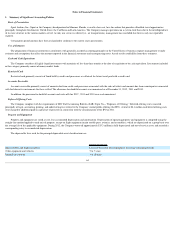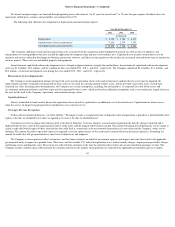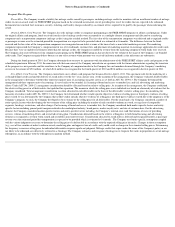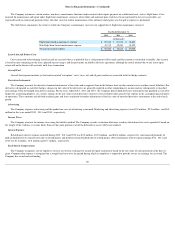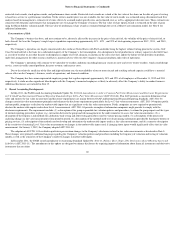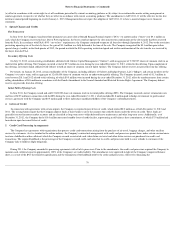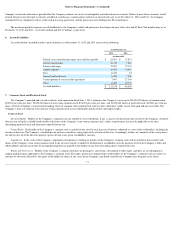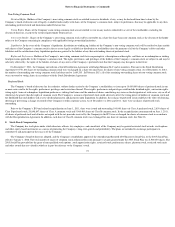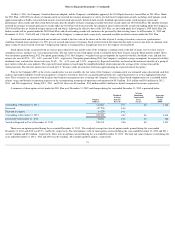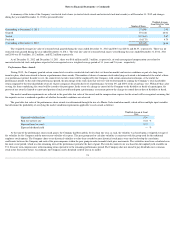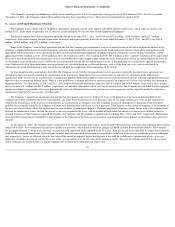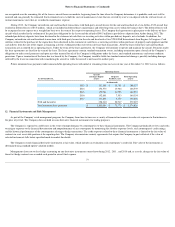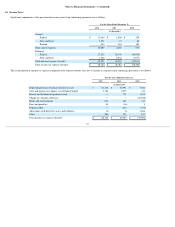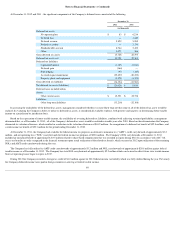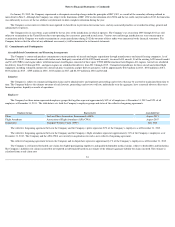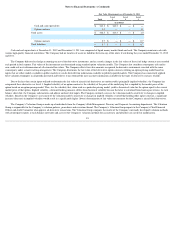Spirit Airlines 2012 Annual Report Download - page 75
Download and view the complete annual report
Please find page 75 of the 2012 Spirit Airlines annual report below. You can navigate through the pages in the report by either clicking on the pages listed below, or by using the keyword search tool below to find specific information within the annual report.
Notes to Financial Statements—(Continued)
A summary of the status of the Company’s restricted stock shares (restricted stock awards and restricted stock unit awards) as of December 31, 2012 and changes
during the year ended December 31, 2012 is presented below:
The weighted-average fair value of restricted stock granted during the years ended December 31, 2012 and 2010 was $20.01 and $6.39 , respectively. There was no
restricted stock granted during the year ended December 31, 2011 . The total fair value of restricted stock shares vested during the years ended December 31, 2012 , 2011
and 2010 was $3.9 million , $3.2 million , and $2.2 million respectively.
As of December 31, 2012 and December 31, 2011 , there was $6.8 million and $1.3 million , respectively, of total unrecognized compensation cost related to
nonvested restricted stock and options expected to be recognized over a weighted-average period of 3.1 years and 2.6 years , respectively.
Performance Share Awards
During 2012 , the Company granted certain senior-level executives restricted stock units that vest based on market and service conditions as part of a long-term
incentive plan, which are referred to herein as performance share awards. The number of shares of common stock underlying each award is determined at the end of a three-
year performance period. In order to vest, the senior level executive must still be employed by the Company, with certain contractual exclusions, at the end of the
performance period. At the end of the performance period, the percentage of the stock units that will vest will be determined by ranking the Company’s total shareholder
return compared to the total shareholder return of 12 peer companies. Based on the level of performance, between 0% and 200% of the award may vest. Within 60 days
after
vesting, the shares underlying the award will be issued to the participant. In the event of a change in control of the Company or the disability or death of a participant, the
payout of any award is limited to a pro-rated portion of such award based upon a performance assessment prior to the change-in-control date or date of disability or death.
The market condition requirements are reflected in the grant date fair value of the award, and the compensation expense for the award will be recognized assuming that
the requisite service is rendered regardless of whether the market conditions are achieved.
The grant date fair value of the performance share awards was determined through the use of a Monte Carlo simulation model, which utilizes multiple input variables
that determine the probability of satisfying the market condition requirements applicable to each award as follows:
At the time of the performance share award grants, the Company had been public for less than one year; as such, the volatility was based upon a weighted average of
the volatility for the Company and the most recent volatility of its peers. The peer group used to calculate volatility is consistent with the group used for the traditional
employee stock options. The Company chose to use historical volatility to value these awards because historical stock prices were used to develop the correlation
coefficients between the Company and each of the peer companies within the peer group in order to model stock price movements. The volatilities used were calculated over
the most recent period, which was the remaining term of the performance period at the date of grant. The risk-free interest rate was based on the implied yield available on
U.S. Treasury zero-coupon issues with remaining terms equivalent to the remaining performance period. The Company does not intend to pay dividends on its common
stock in the foreseeable future. Accordingly, the Company used a dividend yield of zero in its model.
74
Number of Shares
Weighted-Average
Grant Date Fair Value
($)
Outstanding at December 31, 2011
271,999
1.43
Granted
391,418
20.01
Vested
(197,613
)
2.67
Forfeited
(16,175
)
4.79
Outstanding at December 31, 2012
449,629
16.94
Weighted-Average at Grant
Date
Expected volatility factor
0.39
Risk free interest rate
0.44
%
Expected term (in years)
2.72
Expected dividend yield
—
%


